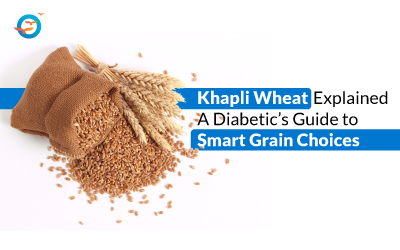Best Wheat for Diabetes

Since man turned from hunting-gathering to agrarian living, bread in some form or the other has been a staple. This is true for people across the world. From soft white breads to homemade flatbreads, there is perhaps no dish as ubiquitous as bread.
Across the Indian subcontinent, the chapatti or roti, as unleavened (made without yeast) flatbreads are known here, are a ubiquitous accompaniment to every meal. Breakfast, lunch, and dinner just wouldn’t be the same without the humble chapatti. And while it has gained much acceptance as a low-calorie food, given its lower Glycemic Index, not all varieties are equal, nor good for diabetics.
Wheat Nutrition
- 100 grams of wheat contain the following nutrition
- Carbohydrates: 72 grams
- Sugar 0.4 grams
- Protein: 13.2 grams
- Water: 10 – 11%
- Calories: ~ 340
- Fiber: 12- 15% (bran)
Advantages and Disadvantages of Wheat
Advantages of wheat
Where diabetics are concerned, wheat—in moderation—makes a good addition to the diet, for the following reasons.
-
Heart-healthy
Whole wheat’s high fiber content helps reduce cholesterol, bringing down the risk of heart-related diabetic complications
-
Good for digestion
The fiber in wheat is also good for your digestion, as its fiber content helps improve digestion and improve gut health.
-
Improves BSL
The fiber in wheat helps slow down the absorption of glucose, keeping your blood sugar levels from spiking, as compared to refined grains such as white bread and rice.
In addition, wheat has a Glycemic Index (GI) of 54, which puts it in the low GI category. This means that it has a low effect on blood sugar levels.
-
Energy booster
The low GI of wheat combined with its carbohydrate content provides a controlled and sustained calorie release, making it a clean source of energy for the body.
Disadvantages of wheat
Diabetics need to be careful about the quantity of wheat consumed, despite its positive health effects for the following reason.
-
Difficult to digest
High fiber content makes wheat a good food for digestion, however, a number of people suffer from a condition known as celiac disease, a chronic digestive and immune disorder that is triggered by foods with gluten—a protein that occurs naturally in grains like wheat, barley, and rye.
There is also evidence to suggest that many people, even those who do not have celiac disease, are sensitive to wheat. Consuming wheat products cause issues like bloating, pain, gas, and diarrhea.
-
Raises cholesterol level
Wheat contains a lot of carbohydrates, which, if eaten in excess, causes blood sugar to rise, and that can be bad for your LDL levels
High demand for wheat and wheat flour has led to a push by manufacturers to increase its shelf life. Unfortunately, the methods used to extend shelf life are not always healthy. Radiation is a common process, and for obvious reasons not the best way to treat your wheat.
Types of wheat for diabetics
All wheat varieties are not created equal. Which is good news for diabetics, because some varieties are proven to help lower blood sugar and provide other health benefits too.
Recommended wheat varieties:
-
Khapli (emmer wheat)
-
Spelt wheat
-
Durum wheat
-
Bansi wheat
-
Red wheat
At Freedom From Diabetes, we strongly recommend shifting from regular wheat to these varieties, for the following reasons. They have a lower GI, which makes them suitable for the diabetic diet.
They are also rich in fiber, vitamins, and minerals that offer a variety of health benefits from regulating blood sugar levels to improving cardiovascular health.
1. Regulates BSL
Wheat varieties like khapli have a low Glycemic index and are also high in fiber. The combination of the two helps reduce the rate of sugar absorption in the blood, thus avoiding spikes in Blood Sugar Levels (BSL), making it the wheat of choice for anyone suffering from insulin-resistance related disorders
2. Easy to digest
Compared to other grains these wheat varieties are lighter on the digestive system. These varieties are higher in fiber than the regular varieties and they have a lower gluten load as well.
As a result, these wheat variants break down easily in the stomach, avoiding problems like flatulence, bloating, and constipation
3. Rich in minerals and vitamins
This may come as a surprise, but regular wheat doesn’t contain the full spectrum of vitamins and minerals that these wheats possess, including niacin (vitamin B3) and several other minerals that help in a variety of ways such as improving cellular health, strengthening bone density, improving dental health, etc. Studies suggest that khapli or emmer wheat also offers arthritis relief, cognitive boost, and helps reduce cholesterol.
Varieties like red wheat are high in protein, and an excellent source of dietary fiber, selenium, and manganese; all of which are necessary for proper metabolism and overall health.
If you can’t think of going without chapatti, we highly recommend shifting from chapattis made from regular wheat flour to flour made from khapli (emmer), Brum, jungli, Bansi, spelt, or indeed any of the ancient wheat varieties. Whether you’re diabetic or not, these wheat variants, with their particular spectrum of nutrients, offer all-around benefits that can enhance everyone’s wellbeing. If you're looking for which rice is best for diabetics, visit here.
FAQs
1. What is the best type of wheat for diabetes?
Some varieties of wheat have been shown to help lower blood sugar and offer additional health benefits.
Khapli (emmer wheat), Spelt wheat, Durum wheat, Bansi wheat, Red wheat.
2. How does whole wheat help with diabetes?
Whole wheat’s high fiber content helps reduce cholesterol and the low GI of wheat bringing down the risk of heart-related diabetic complications.
3. Is wheat good for diabetes?
Wheat contain high Fiber, which is help to lower your blood sugar. Some lower GI wheats Khapli (emmer wheat), Spelt wheat, Durum wheat, can be beneficial for managing blood sugar levels. these wheat variants break down easily in the stomach, avoiding problems like flatulence, bloating, and constipation.
4. How much wheat can I eat if I have diabetes?
Portion control is key. It's important to monitor carbohydrate intake and work with a healthcare provider to find the right amount for your individual needs.

